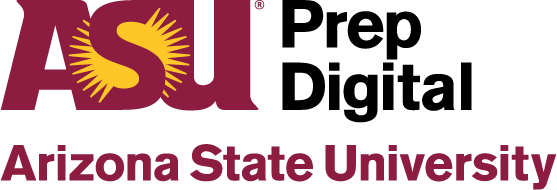Originally published on November 10, 2021 by the74million.org. Written by Julie Young. Managing Director, ASU Prep | Vice President of ASU Educational Outreach.
A story is told about a flood that rose so quickly, a man had to go to the second floor of his home, where he prayed for God to save him. Before long, a neighbor came by in a canoe and yelled to the homeowner, “Come on in. I’ll get you out of here.” The man answered, “No, I’ll be fine. I have faith God will save me. You go help the other neighbors.”
A little while later, the man had to climb into the attic, where he looked out a window and saw the waters rising further. Just then, a fire department rescue boat arrived and urged the man to let them send up a rescuer to bring him down. The man yelled out the window, “No, you go on ahead to the other neighbors. I have faith God will save me.”
The waters rose still further, and the man had to go up on the roof. Not long after, a helicopter came by with a rescue worker dangling from a ladder to hoist the man up. “No, no!” the man said, “I’m going to be fine. God will save me. You go help the other neighbors!”
Soon, the man was swept away in the flood and he died. When he got to heaven, he was sad, dejected and a little angry.
When God asked, “Why the sad face?” the man replied, “I prayed for you to save me, and you didn’t!”
God replied, “I sent you a canoe, a rescue boat, and a helicopter! What more did you expect?!”
The analogy describes the crisis many schools are encountering now as they face a flood of school disruptions, students in quarantine, and a growing number of students being left behind academically. We’ve been given a technological canoe, boat, and helicopter, but we aren’t using them.
In spring of 2020, schools across the nation scrambled to implement the hardware, systems, long-neglected tech infrastructure, software, and online curriculum to serve students in any location. It was the worst possible way to deploy online learning on a national scale, but our nation’s educators had no choice. Dedicated teachers moved mountains to get resources, however imperfect, into the hands of their students and families. District leaders, committed to their teams, did everything in their power to resource and support their staff.
It was messy and monumentally frustrating, and it was a wake-up call to schools and districts everywhere to systematically design for resilience through digitally supported options and alternative learning models.
How is it possible that now, in the fall of 2021, we are nearly back where we started? Nationwide, schools are again being forced into rolling closures, not only because of COVID but also because of teacher shortages, compounded further by legislated mandates regarding face-to-face learning. When it comes to tech infrastructure, content solutions, and teacher readiness, schools are leaps and bounds ahead of where they were pre-pandemic. That’s why it is almost surreal that many schools, facing yet another round of closures, are actually prohibited from leveraging the very infrastructure they built precisely for this purpose.
Teachers are frustrated and exhausted. Both the National Education Association and RAND Corporation released recent data indicating that as many as 32% of teachers in the workforce are considering leaving the profession earlier than anticipated.
An “either/or” polemic has arisen that is hurting our children and our schools. If we have a bucket full of tools in place to help students learn in a wide variety of circumstances and for a wide variety of learning needs, why would we not use them?
In the early years of pioneering online learning in Florida, long before Florida Virtual School emerged as it is today, one of the objections we would hear is that online learning isn’t for everyone. Many believed it was just a solution for advanced students who had the discipline to work independently and that for everyone else, it would be a bust. We found that idea, which we ourselves believed at first, to be untrue over the years. Online learning programs, like any school option, are as effective as the evidence-based practices they adopt and the organizational commitment they hold regarding excellence and compassion.
To the notion that online learning isn’t for every student, we actually agree. A fully online experience is not ideal for every student, though it works for many, but the argument entirely misses the point. Today, we can take the best of the benefits that well-designed learning technologies offer and put them to work in a wide variety of learning models—whether in a fully online, face-to-face (using a blended approach), a hybrid situation where students attend school on certain days and stay home on other days, learning pods where students learn in small neighborhood groups, work-based learning centers—truly our imaginations and our self-imposed boxes are the only limit.
If it is true that all students learn differently and that there is no one-size-fits-all solution, and I believe it is, doesn’t it follow that educators and leaders should provide multiple learning avenues to give students and families options when one model fails to support a student’s progression? We have the ability to do this now; there are no excuses, but like the foolish homeowner, we have put our entire faith in one traditional school model as the end-all solution.
We must stop the either/or thinking that says students should learn fully in-person or nothing. That’s not a solution. In fact, it is a myopic approach to a complex issue, which leaves parents’ hands tied and students with learning gaps through no fault of their own.
We are bordering upon education malpractice, robbing our children of the opportunity to enjoy continuity in their learning during a time when they need it the most. We need a mentality that embraces multiple models, pathways, and instructional delivery mechanisms. This is a mindset that respects the multiple differences of our students.
I implore leaders everywhere to imagine and strive for an education system that offers our students not just one path to post-secondary learning but many. It takes courage and patience to wade through the funding, legislative, logistical, and pedagogical challenges, but we should not be like the foolish homeowner who, caught in his own image of the “ideal” solution, failed to put the real tools right in front of him to work.
Julie Young is the managing director of ASU Prep Academy and ASU Prep Digital. She was previously the founding president and CEO of Florida Virtual School, the world’s first virtual statewide school district.


